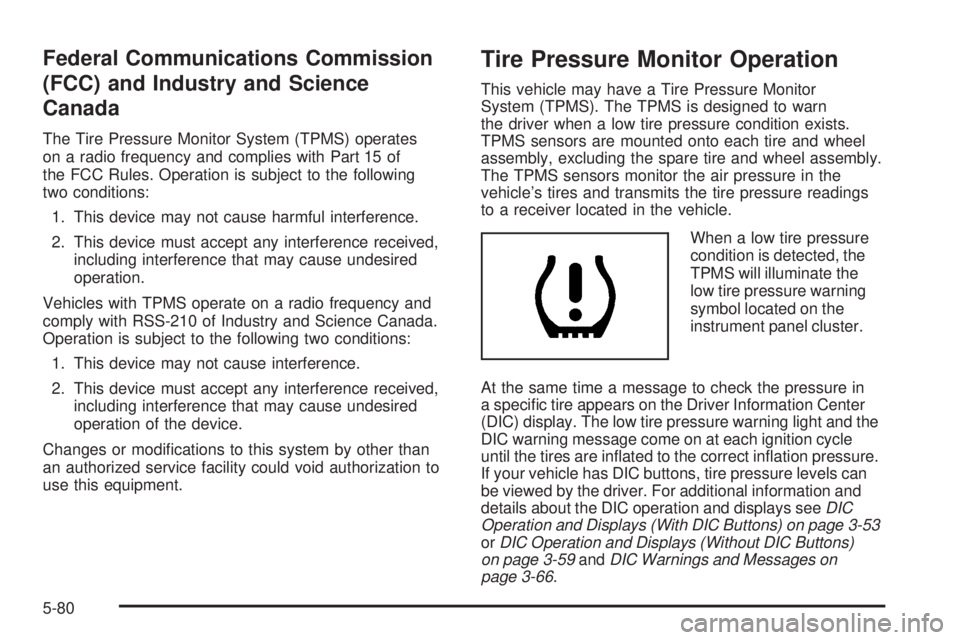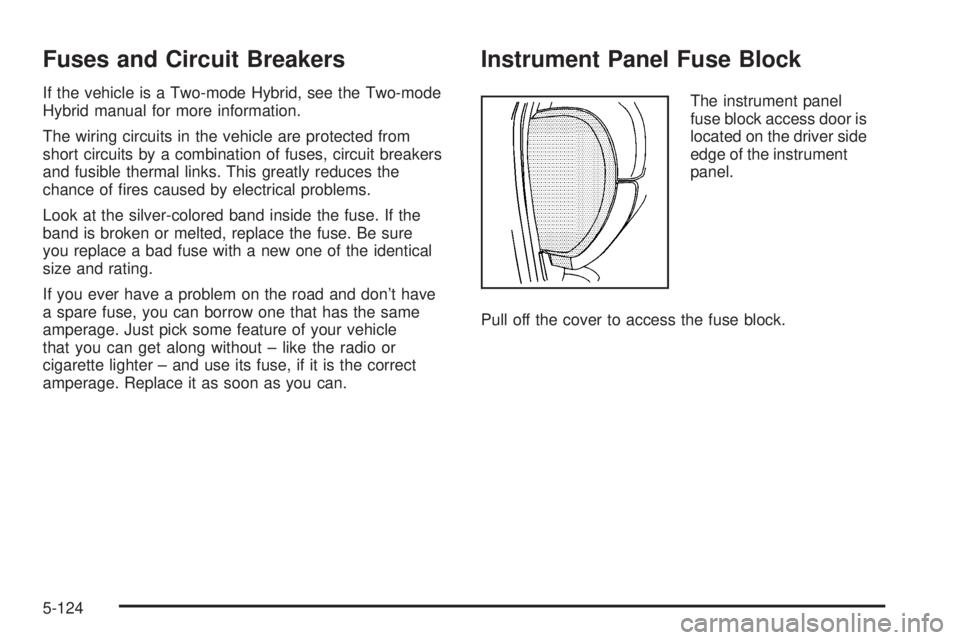2009 GMC SIERRA 1500 radio
[x] Cancel search: radioPage 490 of 602

Federal Communications Commission
(FCC) and Industry and Science
Canada
The Tire Pressure Monitor System (TPMS) operates
on a radio frequency and complies with Part 15 of
the FCC Rules. Operation is subject to the following
two conditions:
1. This device may not cause harmful interference.
2. This device must accept any interference received,
including interference that may cause undesired
operation.
Vehicles with TPMS operate on a radio frequency and
comply with RSS-210 of Industry and Science Canada.
Operation is subject to the following two conditions:
1. This device may not cause interference.
2. This device must accept any interference received,
including interference that may cause undesired
operation of the device.
Changes or modi�cations to this system by other than
an authorized service facility could void authorization to
use this equipment.
Tire Pressure Monitor Operation
This vehicle may have a Tire Pressure Monitor
System (TPMS). The TPMS is designed to warn
the driver when a low tire pressure condition exists.
TPMS sensors are mounted onto each tire and wheel
assembly, excluding the spare tire and wheel assembly.
The TPMS sensors monitor the air pressure in the
vehicle’s tires and transmits the tire pressure readings
to a receiver located in the vehicle.
When a low tire pressure
condition is detected, the
TPMS will illuminate the
low tire pressure warning
symbol located on the
instrument panel cluster.
At the same time a message to check the pressure in
a speci�c tire appears on the Driver Information Center
(DIC) display. The low tire pressure warning light and the
DIC warning message come on at each ignition cycle
until the tires are in�ated to the correct in�ation pressure.
If your vehicle has DIC buttons, tire pressure levels can
be viewed by the driver. For additional information and
details about the DIC operation and displays seeDIC
Operation and Displays (With DIC Buttons) on page 3-53
orDIC Operation and Displays (Without DIC Buttons)
on page 3-59andDIC Warnings and Messages on
page 3-66.
5-80
Page 492 of 602

One or more TPMS sensors are missing or
damaged. The DIC message and the TPMS
malfunction light should go off when the TPMS
sensors are installed and the sensor matching
process is performed successfully. See your
dealer/retailer for service.
Replacement tires or wheels do not match your
vehicle’s original equipment tires or wheels. Tires
and wheels other than those recommended for your
vehicle could prevent the TPMS from functioning
properly. SeeBuying New Tires on page 5-86.
Operating electronic devices or being near facilities
using radio wave frequencies similar to the TPMS
could cause the TPMS sensors to malfunction.
If the TPMS is not functioning it cannot detect or
signal a low tire condition. See your dealer/retailer for
service if the TPMS malfunction light and DIC message
comes on and stays on.
TPMS Sensor Matching Process
Each TPMS sensor has a unique identi�cation code.
Any time you rotate your vehicle’s tires or replace one
or more of the TPMS sensors, the identi�cation codes
will need to be matched to the new tire/wheel position.
The sensors are matched to the tire/wheel positions in
the following order: driver side front tire, passenger side
front tire, passenger side rear tire, and driver side rear tire
using a TPMS diagnostic tool. See your dealer/retailer for
service.
The TPMS sensors can also be matched to each
tire/wheel position by increasing or decreasing the
tire’s air pressure. If increasing the tire’s air pressure,
do not exceed the maximum in�ation pressure indicated
on the tire’s sidewall.
To decrease air-pressure out of a tire you can use the
pointed end of the valve cap, a pencil-style air pressure
gage, or a key.
You have two minutes to match the �rst tire/wheel
position, and �ve minutes overall to match all four
tire/wheel positions. If it takes longer than two minutes,
to match the �rst tire and wheel, or more than
�ve minutes to match all four tire and wheel positions
the matching process stops and you need to start over.
5-82
Page 534 of 602

Fuses and Circuit Breakers
If the vehicle is a Two-mode Hybrid, see the Two-mode
Hybrid manual for more information.
The wiring circuits in the vehicle are protected from
short circuits by a combination of fuses, circuit breakers
and fusible thermal links. This greatly reduces the
chance of �res caused by electrical problems.
Look at the silver-colored band inside the fuse. If the
band is broken or melted, replace the fuse. Be sure
you replace a bad fuse with a new one of the identical
size and rating.
If you ever have a problem on the road and don’t have
a spare fuse, you can borrow one that has the same
amperage. Just pick some feature of your vehicle
that you can get along without – like the radio or
cigarette lighter – and use its fuse, if it is the correct
amperage. Replace it as soon as you can.
Instrument Panel Fuse Block
The instrument panel
fuse block access door is
located on the driver side
edge of the instrument
panel.
Pull off the cover to access the fuse block.
5-124
Page 567 of 602

Customer Assistance and Information...............7-2
Customer Satisfaction Procedure......................7-2
Online Owner Center......................................7-5
Customer Assistance for Text Telephone
(TTY) Users...............................................7-6
Customer Assistance Offices............................7-6
GM Mobility Reimbursement Program................7-7
Roadside Assistance Program..........................7-7
Scheduling Service Appointments....................7-10
Courtesy Transportation Program....................7-10
Collision Damage Repair................................7-12Reporting Safety Defects................................7-15
Reporting Safety Defects to the
United States Government..........................7-15
Reporting Safety Defects to the
Canadian Government................................7-15
Reporting Safety Defects to General Motors.....7-15
Service Publications Ordering Information.........7-16
Vehicle Data Recording and Privacy................7-17
Event Data Recorders...................................7-18
OnStar
®......................................................7-19
Navigation System........................................7-19
Radio Frequency Identi�cation (RFID)..............7-19
Section 7 Customer Assistance Information
7-1
Page 583 of 602

ORDER TOLL FREE: 1-800-551-4123
Monday-Friday 8:00 AM - 6:00 PM
Eastern Time
For Credit Card Orders Only
(VISA-MasterCard-Discover), visit Helm, Inc.
on the World Wide Web at: helminc.com
Or you can write to:
Helm, Incorporated
P.O. Box 07130
Detroit, MI 48207
Prices are subject to change without notice and without
incurring obligation. Allow ample time for delivery.
Note to Canadian Customers: All listed prices are
quoted in U.S. funds. Canadian residents are to make
checks payable in U.S. funds.
Vehicle Data Recording and
Privacy
Your GM vehicle has a number of sophisticated
computers that record information about the vehicle’s
performance and how it is driven. For example, your
vehicle uses computer modules to monitor and control
engine and transmission performance, to monitor the
conditions for airbag deployment and deploy airbags in a
crash and, if so equipped, to provide antilock braking to
help the driver control the vehicle. These modules may
store data to help your dealer/retailer technician service
your vehicle. Some modules may also store data about
how you operate the vehicle, such as rate of fuel
consumption or average speed. These modules may also
retain the owner’s personal preferences, such as radio
pre-sets, seat positions, and temperature settings.
7-17
Page 585 of 602

OnStar®
If your vehicle has OnStar and you subscribe to the
OnStar services, please refer to the OnStar Terms and
Conditions for information on data collection and use.
See alsoOnStar
®System on page 2-70in this manual
for more information.
Navigation System
If your vehicle has a navigation system, use of the
system may result in the storage of destinations,
addresses, telephone numbers, and other trip
information. Refer to the navigation system operating
manual for information on stored data and for deletion
instructions.
Radio Frequency
Identi�cation (RFID)
RFID technology is used in some vehicles for functions
such as tire pressure monitoring and ignition system
security, as well as in connection with conveniences such
as key fobs for remote door locking/unlocking and
starting, and in-vehicle transmitters for garage door
openers. RFID technology in GM vehicles does not use
or record personal information or link with any other GM
system containing personal information.
7-19
Page 587 of 602

A
Accessories and Modi�cations............................ 5-4
Accessory Power............................................2-23
Accessory Power Outlets.................................3-22
Active Fuel Management™...............................2-28
Adding a Snow Plow or Similar Equipment.........4-40
Adding Equipment to Your Airbag-Equipped
Vehicle.......................................................1-90
Additional Required Services, Scheduled
Maintenance................................................. 6-7
Additives, Fuel................................................. 5-8
Add-On Electrical Equipment...........................5-123
Adjustable Throttle and Brake Pedal..................2-26
Air Cleaner/Filter, Engine.................................5-22
Air Conditioning......................................3-24, 3-25
Airbag
Readiness Light..........................................3-37
Airbag System................................................1-72
Adding Equipment to Your Airbag-Equipped
Vehicle...................................................1-90
Airbag Off Switch........................................1-81
How Does an Airbag Restrain?......................1-79
Passenger Sensing System...........................1-84
Servicing Your Airbag-Equipped Vehicle..........1-89
What Makes an Airbag In�ate?......................1-79Airbag System (cont.)
What Will You See After an Airbag In�ates?....1-80
When Should an Airbag In�ate?....................1-77
Where Are the Airbags?...............................1-75
Airbags
Off Light.....................................................3-38
Passenger Status Indicator...........................3-40
Antenna
Fixed Mast................................................3-142
Antenna, XM™ Satellite Radio Antenna
System.....................................................3-142
Antilock Brake System (ABS)............................. 4-5
Warning Light.............................................3-43
Appearance Care
Aluminum or Chrome-Plated Wheels.............5-120
Care of Safety Belts...................................5-118
Chemical Paint Spotting..............................5-122
Cleaning Exterior Lamps/Lenses..................5-119
Fabric/Carpet............................................5-116
Finish Care...............................................5-119
Finish Damage..........................................5-121
Instrument Panel, Vinyl, and Other Plastic
Surfaces...............................................5-117
Interior Cleaning........................................5-115
Leather....................................................5-117
Sheet Metal Damage..................................5-121
1
Page 588 of 602

Appearance Care (cont.)
Tires........................................................5-121
Underbody Maintenance.............................5-122
Washing Your Vehicle.................................5-118
Weatherstrips............................................5-118
Windshield and Wiper Blades......................5-120
Ashtray.........................................................3-23
Assistance Program, Roadside........................... 7-7
Audio System.................................................3-84
Audio Steering Wheel Controls....................3-140
Navigation/Radio System, see Navigation
Manual.................................................3-118
Setting the Clock.........................................3-85
XM™ Satellite Radio Antenna System...........3-142
Audio System(s).............................................3-87
Audio Systems
Radio Reception........................................3-141
Rear Seat (RSA).......................................3-138
Theft-Deterrent Feature...............................3-140
Automatic Headlamp System............................3-18
Automatic Transmission
Fluid..................................................5-24, 5-27
Operation...................................................2-28
Auxiliary
Roof Mounted Lamp....................................3-19
Axle, Rear.....................................................5-51B
Battery..........................................................5-45
Electric Power Management..........................3-21
Run-Down Protection...................................3-22
Belt Routing, Engine.......................................6-18
Bluetooth
®....................................................3-118
Brake
Emergencies................................................ 4-6
Pedal and Adjustable Throttle........................2-26
Brake Fluid....................................................5-41
Brakes..........................................................5-41
Antilock....................................................... 4-5
Parking......................................................2-50
System Warning Light..................................3-42
Braking........................................................... 4-4
Braking in Emergencies..................................... 4-6
Break-In, New Vehicle.....................................2-22
Bulb Replacement...........................................5-66
Center High-Mounted Stoplamp (CHMSL)
and Cargo Lamp......................................5-62
Fog Lamp ..................................................3-19
Halogen Bulbs............................................5-61
Headlamp Aiming........................................5-58
Headlamps.................................................5-61
2